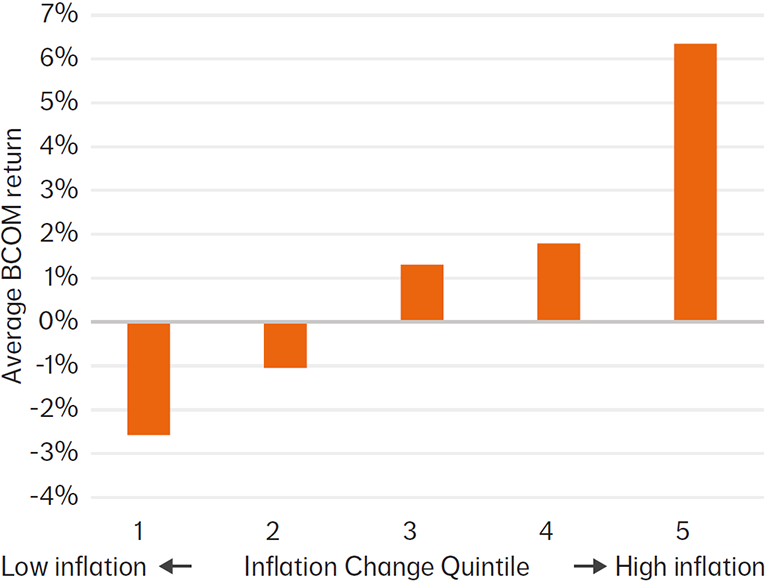Don’t look now, but your wallet may feel a bit skinny these days. We’re paying more at the pump, more at the grocery store, and even more for a pair of new shoes. After being dormant—and even declining—over the last few years, inflation is rearing its ugly head once more. The growing global economy and snapback from the COVID-19 crisis is causing prices to increase across the board. Now, investors are once again being forced to deal with inflation.
And there are numerous ways to do just that.
However, one tried and true way of fighting inflation could provide the necessary bump both today and tomorrow to protect your purchasing power. It’ll even provide some diversification benefits as well. We’re talking about commodities of course.
With the boom in exchange traded funds (ETFs) and similar vehicles, adding a dose of commodities to a portfolio has never been easier.
Use the Dividend Screener to find the security that meets your investment criteria including commodity producers.
A Recent Surge in Inflation
As the coronavirus pandemic has waned and the global economy has started to move, prices are on the rise. Whether it’s due to pent-up demand, large stimulus packages or low rates, inflation has steadily moved higher this year and has culminated in a sharp spike to the main measure: the consumer price index (CPI).
According to the Labor Department, the CPI jumped 0.6% month-over-month in March. Year-over-year, the metric surged 2.6%. This was the fastest rate of inflation since August 2018 and well above the 1.7% jump recorded in February. Looking at the core-CPI—which kicks out volatile energy and food prices—also painted a similar picture. Economists’ estimates for April’s CPI reading are now running higher than originally predicted.
For investors, this is an issue. Thanks to years of low- to- non-existent inflation, deciding how to fight rising prices hasn’t been at the forefront of our minds. However, inflation can significantly impact our ability to spend our savings. For example, you need $152 today to buy the same amount of goods you could back in 2001. And that’s only with inflation running at 2.11% in that decade.
With inflation now becoming the norm again, investors need to focus their attention on the issue.
Looking Toward Commodities
There are numerous ways to fight inflation, from dividend growth stocks to treasury inflation protected bonds (TIPs). But commodities may offer an interesting play on inflation with some added benefits.
Commodities have long been an outlier when it comes to investing for most individual portfolios and refer to the primary building blocks of the economy. They involve physical goods rather than finished products. Soft commodities are agricultural products such as wheat, coffee, cocoa, fruit, and sugar, while hard commodities are mined, including gold and oil. Generally, natural resources are purchased or traded via a system of futures, options, and other derivatives.
Because commodities represent the ‘core’ building blocks of our lives, they are directly tied to demand and a growing economy. When we eat more food, cattle, corn, and wheat prices go up. When we buy more cars, iron ore and crude oil prices surge. It is as simple as that.
Just take a look at this chart from NN Investment Partners and inflation data from January 1970 to December 2020. As you can see, as inflation increases—as measured by the U.S. CPI Urban Consumer Index—the returns for a broad basket of commodities (as indicated by the Bloomberg Commodity index) also increase.

Source: NN Investment Partners
Breaking out the major drivers of inflation—food and energy—NN Partners also found that the BCOM was able to perform well during the five major spikes in food/energy inflation since the 1970s. It returned as much as 164% during the highest spike and 32% during the smallest one. You can see this return even today. Through the end of the first quarter, the S&P GSCI—another broad benchmark of commodities—was the top-performing asset class with a 15% gain.
Meanwhile, commodities offer another win for portfolios: non-correlation to stocks and bonds. Historically, commodities offer low to negative correlation to traditional asset classes. They truly move in different ways and, as such, commodities offer one of the only ‘free lunches’ left when it comes to diversification.
Getting Your Commodity Fix
Using commodities in a portfolio doesn’t have to be complicated. No longer do you need to open a futures account or pay hefty management fees to invest in the asset class. Low-cost ETFs can do the heavy lifting.
Learn more about commodity mutual funds and ETFs here.
Two of the earliest ETFs in the sector are still among the biggest and easiest ways to own a broad-basket of commodities. The Invesco DB Commodity Index Tracking Fund (DBC) and iShares S&P GSCI Commodity-Indexed Trust (GSG) offer broad exposure to the theme. However, their exposure weights are a bit different, with the GSG being more weighted toward energy commodities. Both ETFs are structured as partnerships, so investors will get a K-1 statement.
Another way to get some commodity exposure and fight inflation is through stocks of firms that produce commodities. After all, if your profits are directly tied to what you dig out of the ground, the higher the price for that resource, the higher your profits/cash flows. Stocks like Exxon (XOM), Freeport-McMoRan (FCX) or BHP Billiton (BHP) are prime dividend-paying examples. Meanwhile, the SPDR S&P Global Natural Resources ETF (GNR) offers a broad basket of natural resources firms. While not a perfect inflation hedge, commodity firms do produce a leveraged effect due to their fixed costs.
The Bottom Line
Inflation is now rising and is poised to grow as the economy reopens, interest rates stay low, and vaccines are rolled out. Commodities offer a compelling play for investors who want to fight the effects of inflation and keep their portfolio growing in the new environment.
Keep track of the latest news in our News section, where we regularly publish the latest around dividend investing.

